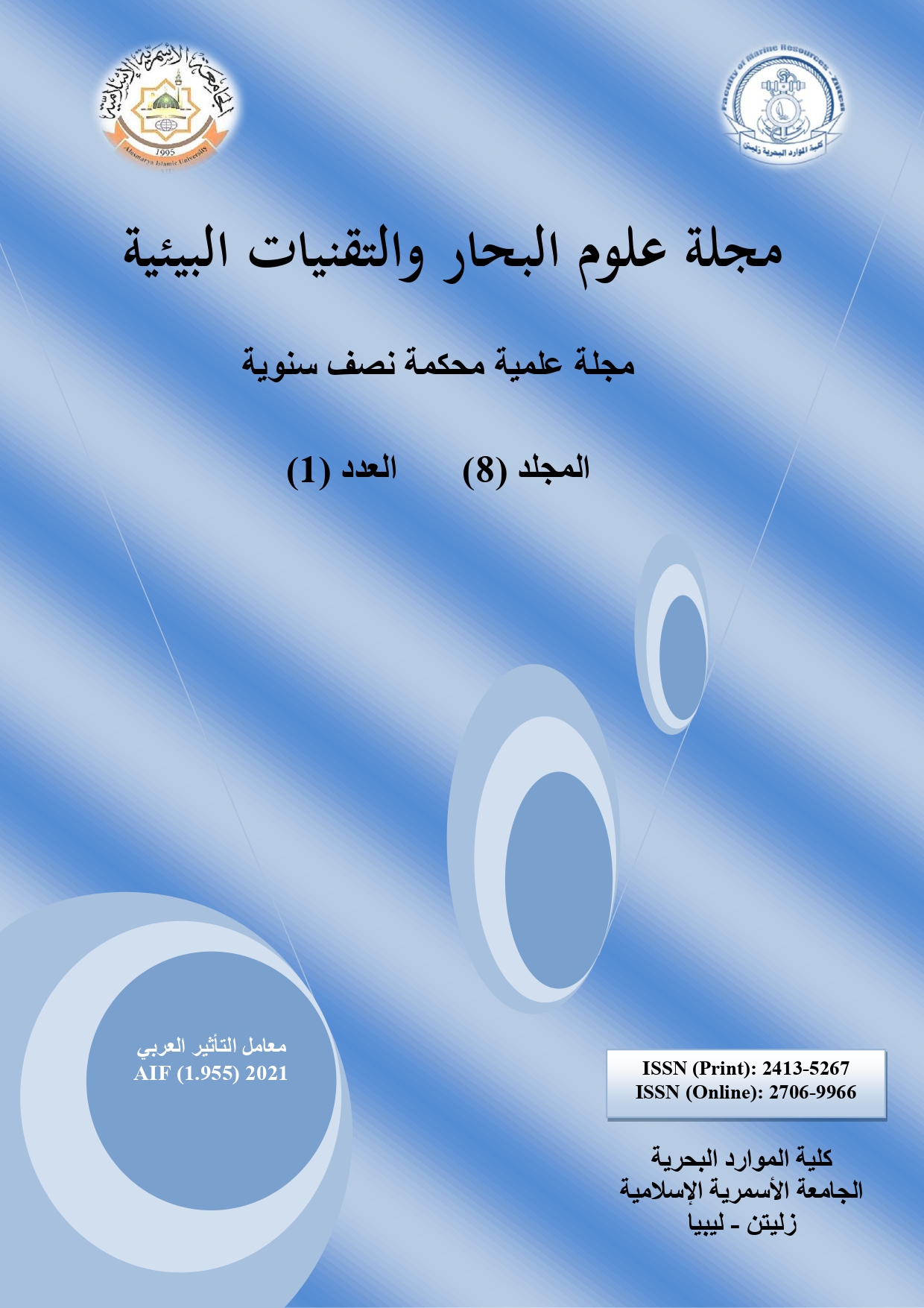دراسة صورة أشعة لهيكل غضروفي لسمكة بقرة مدورة Taeniura grabata من ساحل سوسة، ليبيا
DOI:
https://doi.org/10.59743/jmset.v8i1.2الكلمات المفتاحية:
البقرة المدورة، Taeniura grabata، صورة اشعاعية، ساحل سوسة، ليبياالملخص
تم تثبيت عينة من سمكة البقرة المدورة Taeniura grabata من ميناء سوسة ليبيا، في وضع ظهري-بطني، بُغية تشخيص الهيكل العظمي وصفائح الأسنان، باستخدام منظومة سمينز للأشعة السينية (Multix Fusion). وبدراسة التدرج اللوني للصورة، كان الهيكل العظمي أبيضًا باهتًا للغاية ناحية الهيكل العظمي المحوري وأجزاء من الجمجمة، مشيراً إلى تكلس ضعيف، بينما كانت الألوان الداكنة من العضلات السطحية، كما حصرت 88 شعاعيًا صدرياً: 41 شعاعيًا شعاعيًا و15 متوسطًا و32 شعاعيًا متحولًا مع 22 شعاعا حوضياً، كما لوحظ ربط شعاعي الزعانف بالكتف بواسطة ثلاثة إشعاعاتٍ قاعدية مكبرة، تم حصر 80 فقرة قبل الابرة و50 بعدها مع 62 فقرة قبل الذيلية، في 192 فقرة بالذيل. كان هناك 32 صفًا علويًا و36 صفًا سفليًا من الأسنان الصغيرة والغير حادة، والمرتبة في أسطح مفلطحة، بينما كان القحف العصبي مستطيل قليلاً، أطول من عرضه بمرة ونصف، كانت الجيوب الخيشومية حوالي 30٪ من القحف العصبي طولاً، كما كانت غضاريف ميكيل عريضة وواسعة ومثلثة، وقد تألف الهيكل الخيشومي من خمسة أقواس، مع بروز جسر صغير واحد بطني من اللوحة الوسطى، الفكوك قوية جدًا وصغيرة وينطبق عليها شكل كسارة اللوز، مثل هذا العمل قد يفيد في مزيد من الدراسات الفسيولوجية لأسماك الساحل الليبي في المستقبل.
التنزيلات
المراجع
Abdallah (2007). Sharks and Rays of the Red Sea and the Gulf of Aden. FAO species Identification Cards. FAO, Rome, p. 110.
Abu-Grarah A.R. (2008). Biological studies on Diplodus sargus from Benghazi, Libya. M.Sc. dissertation, Department of Marine Resources, Faculty of Natural Resources and Environmental Sciences, University of Omar Al-Mukhtar, p. 110.
Abu-Madinah H.M. (2008). The Libyan harbors – A study in the Economic geography. 2nd edition. The international house of books, Benghazi, Libya, p. 368.
Al-Shubka H.A. (2009). The Descriptive Atlas of Chordates structure and Anatomy. Al-Dar Al-Arabyia for Books, p. 244.
Alfaro M.E., Janovetz J., and Westneat, M.W. (2001). Motor control across trophic strategies: muscle activity of biting and suction feeding fishes. American Zoologist, 41(6): 1266-1279.
Ali M., Saad A., Reynaud C., and Capape C. (2013). First records of the Round Fantail Stingray, Taeniura grabata (Chondrichthyes: Dasyatidae), off the Syrian coast (eastern Mediterranean). Zoology in the Middle East, 59: 176-178.
Aschliman N. (2011). The batoid tree of life: recovering the patterns and timing of the evolution of skates, rays and allies (Chondrichthyes, Batoidea). PhD dissertation, Florida State University, Tallahassee, p. 184.
Başusta N., Erdem Ü., and Kumlu M. (1998). Two new fish records for the Turkish seas: round stingray Taeniura grabata and skate stingray Himantura uarnak (Dasyatidae). ----- Journal of Zoology, 44: 65-66
Bauchot M.L. (1987). Raies et autres batoides. p. 845-886. In W. Fischer, M.L. Bauchot and M. Schneider (eds.) Fiches FAO d'identificationpour les besoins de la pêche. (rev. 1). Mèditerranéeet mer Noire. Zone de pêche 37. Vol. II. Commission des Communautés Européennes and FAO, Rome
Ben-Abdalla A.R., Al-Gmati H., Kasim A.A., Al-Turkie A.A., and Ben-Moussa M.N. (2012). Guide to cartilaginous fishes in Libyan waters. Marine biology Research Center (MBRC) - Tajoura’a, Libya, p. 100.
Bond, C. E. (1996). Biology of fishes, 2nd edn. Philadelphia, PA: Saunders College Publishing
Bradai M.N., Saidi B., and Enajjar S. (2012). Elasmobranchs of the Mediterranean and Black sea: status, ecology and biology. Bibliographic analysis. Studies and Reviews.General Fisheries Commission for the Mediterranean.No. 91. FAO, Rome. 103 pp
Buzaid E.M.K. and El-Mor M.E.E. (2015). Feeding Habits of the Copper Shark, Carcharhinus brachyurus (Günther, 1870) from Ain El-Ghazala Lagoon, Eastern Libya during the Period from February till June 2013. Journal of Life Sciences, 9: 347-355.
Buzaid E.M.K. (2019). Biometric study of Common Guitarfish Rhiniobatus rhinobatus in Dernah coast, Libya (June – December 2016). International Journal of Pharmacy & Life Sciences, 10 (11-12): 6388-6396.
Buzaid E.M.K., Ali S.M., and Ali R.A.S. (2020). Morphological aspects of Common Torpedo (Torpedo torpedo) in by-catch in Sidi Sha’ab Harbour, Tripoli, Libya, Central Asian Journal of Environmental Science and Technology Innovation, 2: 77-84.
Capapé C. and Desoutter M. (1990). Dasyatidae. p. 59-63. In J.C. Quero, J.C. Hureau, C. Karrer, A. Post and L. Saldanha (eds.) Check-list of the fishes of the eastern tropical Atlantic (CLOFETA). JNICT, Lisbon; SEI, Paris; and UNESCO, Paris.Vol. 1
Coles R.J. (1910). Observations on the habits and distribution of certain fishes taken on the coast of North Carolina. Bulletin of the American Museum of Natural History. 28:338–341.
Compagno L.J.V. (1999). Endoskeleton, in WC Hamlett [ed.] 69-92, In: Sharks, Skates, and Rays: The Biology of Elasmobranch Fishes. Johns Hopkins Univ. Press.
Cowley P.D. and Compagno L.J.V. (1993). A taxonomic re-evaluation of the blue stingray from southern Africa (Myliobatiformes: Dasyatidae). South African Journal of Marine Science, 13(1): 135-149.
Culpepper E. and Mylniczenko N. (2017). Stingray anatomy and ultrasound. National Aquarium Baltimore & Disney’s Animals, Sciences and Environment
De Carvalho M.R., Maisey J.G., and Grande L. (2004). Freshwater stingrays of the Green River Formation of Wyoming (Early Eocene), with the description of a new genus and species and an analysis of its phylogenetic relationships (Chondrichthyes: Myliobatiformes). Bulletin of the American Museum of Natural History, 284: 1-136.
De Carvalho M.R. and Argo M.P. (2011). An unusual, dwarf new species of neotropicAl freshwater stingray, Plesiotrygon nana sp. nov., from the upper and mid Amazon basin: the second species of Plesiotrygon (chondrichthyes: potamotrygonidae), Papéis Avulsos de Zoologia, 51(7):101-138.
Dean M.N. and Summers A.P. (2006). Mineralized cartilage in the skeleton of chondrichthyan fishes. Zoology, 190: 164–168
Desse J., Desse-Berset N., and Rocheteau, M. (1989). Les profils rachidiens globaux. Reconstitution de lataille des poisons etap - préciation du nombre minimal d’individus à partir des pieces rachidiennes Review of Paléobiology, 8: 89-94. (In French)
Dulvy N.K. and Reynolds J.D. (1997). Evolutionary transitions among egg-laying, live-bearing and maternal inputs in sharks and rays. Proc. R. Soc. Lond., Ser. B: Biol. Sci., 264:1309-1315.
Duncan W.P., da Silva M.I., and Fernandes M.N. (2015). Gill dimensions in near-term embryos of Amazonian freshwaterstingrays (Elasmobranchii: Potamotrygonidae) and their relationship to the lifestyle and habitat of neonatal pups. Neotropical Ichthyology, 13(1): 123-136.
Enault S., Auclair C., Adnet S. and DebiaisThibaud M. (2016). A complete protocol for the preparation of chondrichthyan skeletal specimens. Journal of Applied Ichthyology, 32(3): 409-415.
Ferry-Graham, L.A., Wainwright, P.C. and Lauder, G.V. (2003). Quantification of flow during suction feeding in bluegill fishes. Zool. 106: 159-168.
Francis W. (1968). Report on the Guinean Trawling Survey, Volume 1. NODC general series, OAU/STRC publication 99
Franklin O., Palmer C., and Dyke G. (2014). Pectoral Fin Morphology of Batoid Fishes (Chondrichthyes: Batoidea): Explaining Phylogenetic Variation with Geometric Morphometrics. Journal of Morphology, 275: 1173–1186.
Gal J.M. (1993). Mammalian spinal biomechanics. Static and dynamic mechanical properties of intact intervertebral joints. J. Exp. Biol., 174: 247 – 280.
Golani D., Öztürk B., and Basusta B. (2006). Fishes of the Eastern Mediterranean. Turkish Marine Research Foundation, p. 264.
Heemstra P.C. and Smith M.M. (1980). Hexatrygonidae, a new family of stingrays (Myliobatiformes: Batoidea) from South Africa, with comments on the classification of batoid fishes. Ichthyol., (43): 1-17.
Hughes G.M., Perry S.F., and Piiper J. (1986). Morphometry of the gills of the elasmobranch Scyliorhinus stellaris in relation to body size. Journal Experimental Biology, 121: 27-42.
Hurov J.R. (1987). Terrestrial locomotion and back anatomy in vervet (Circopithecus aethiops) and patas (Erythrocebus patas) monkeys. Am. J. Primatol. 13: 297–311.
Iglésias S.P. (2006). Chondrichthyans from the North-eastern Atlantic and the Mediterranean - A natural classification based on collection specimens - plates & text, V. 2. (In French)
Jensen A., Collins K.J., and Lockwood A.P.M. (2000). Artificial Reefs in European Seas. Springer, p. 245.
Kubo Y. and Asano H. (1987). Growth type of vertebral central and the hard tissue observed by microradiography of the rainbow trout. Nippon Suisan Gakkaishi, 53: 1367-1372.
Lauder G.V. (1985). Aquatic feeding in lower vertebrates. In: Hildebrand M, Bramble DM, Liem KF, Wake D, editors. Functional vertebrate morphology. Cambridge, MA: Harvard University Press. p 210-229.
Le Port A., Pawley M.D.M., and Lavery S.D. (2013). Speciation of two stingrays with antitropical distributions: low levels of divergence in mitochondrial DNA and morphological characters suggest recent evolution. Aquatic Biology, 19(2): 153-165.
Learm J. (1976). The development, function, and design of amphicoelous vertebrae in teleost fishes. Zoological Journal of Linnaean Society, 58: 237-254.
Liem K.F. (1976). Evolution of the scale-eating cichlid fishes of Lake Tanganyika: a generic revision with a description of a new species. Bull Mus Comp Zool., 147: 319–350.
Liem K.F. (1980). Adaptive significance of intra-and interspecific differences in the feeding repertoires of cichlid fishes. American zoologist, 20(1): 295-314.
Lindsey C.C. (1978). Form, function and locomotory habits in fish. In: Hoar, W.S., Randall, D. J. (eds.). Fish Physiology, Academic Press, New York, p1-100.
Liu X., Dean M.N., Summer A.P., and Earthman J.C. (2010). Composite model of the shark′s skeleton in bending: a novel architecture for biomimetic design of functional compression bias. Materials Science and Engineering, C, 30: 1077-1084.
Liu X., Dean M.N., Youssef pour H., Summers A.P., and Earthman J.C. (2014). Stress relaxation behavior of tessellated cartilage from the jaws of blue sharks. journal of the mechanical behavior of biomedical materials, 29: 68-80.
Long J.H., Koob T., Schaefer J., Summers A.P., Bantilan K., Grotmol S., and Porter M.E. (2011). Inspired by sharks: a biomimetic skeleton for the flapping, propulsive tail of an aquatic robot. Mar. Technol. Soc. J., 45: 119–129.
Lovejoy N.R. (1996). Systematics of myliobatoid elasmobranchs: with emphasis on the phylogeny and historical biogeography of neotropical freshwater stingrays (Potamotrygonidae: Rajiformes). Zoological Journal of the Linnean Society, 117: 207–257.
Macesic, L.J. and Summers, A.P. (2012). Flexural stiffness and composition of the batoid propterygium as predictors of punting ability. Journal of Experimental Biology, 215: 2003–2012
MBRC (2005). Atlas of the Mediterranean Sea. Marine Biology Research Center (MBRC), Tajura’, Tripoli, p. 135.
Miyake T. (1988). The systematics of the genus Urotrygon with comments on the interrelationship within Urolophidae (Chondrichthyes, Myliobatiformes). Ph.D. Thesis, Texas A & M University, College Station, Texas.
Motta, P.J., Hueter, R.E. and Tricas, T.C. (1991). An electromyographic analysis of the biting mechanism of the lemon shark, Negaprion brevirostris: functional and evolutionary implications. Journal of Morphology, 210(1): 55-69.
Muller, M. and Osse, J.W.M. (1984). Hydrodynamics of suction feeding in fish. Trans. Zool. Soc. Lond. 37: 51–135.
Nishida, K. (1990). Phylogeny of the suborder Myliobatidoidei. Memoirs of the faculty of fisheries Hokkaido University, 37(1-2): 1–108.
Nowroozi B.N. and Brainerd E.L. (2012). Regional variation in the mechanical properties of the vertebral column during lateral bending in Morone saxatilis. J. R. Soc. Interface, 9: 2667–2679.
Officer R.A., Gason A.S., Walker T.I., Clement J.G. (1996). Sources of variation in counts of growth incrementsin vertebrae from gummy shark, Mustelus antarcticus and school shark Galeorhinus galeus: implications for age determination. Can J Fish Aquat Sci. 53:1765–1777.
Panjabi M.M., Crisco J.J., Vasavada A., Oda T., Cholewicki J., Nibu K., and Shin E. (2001). Mechanical properties of the human cervical spine as shown by three-dimensional load– displacement curves. Spine, 26: 2692–2700.
Perry S.F. (1990). Recent advances and trends in the comparative morphometry of vertebrate gas exchange organs. Pp. 43- 71. In: Boutilier, R. G. (Ed.). Advances in comparative and environmental physiology. New York, Springer-Verlag.
Porter M.E., Roque C.M., and Long J.H. (2009). Turning maneuvers in sharks: predicting body curvature from body and vertebral morphology. J. Morphol., 270: 954–965.
Qasim M.Q. (1995). Comparative Anatomy for Vertebrates. Omar Al-Mukhtar University, Albayda, Libya, 526 pp
Raoult V., Peddemors V.M., Zahra D., Howell N., Howard D.L., De Jonge M.D., and Williamson J.E. (2016). Strontium mineralization of shark vertebrae, Scientific Reports, 6: 29698.
Reynolds J.E., Abukhader A., and Ben Abdallah A. (1995). The marine wealth sector of Libya: a development planning overview. Food and Agriculture Organization (FAO), Division of Fishery and Aquaculture Economics and Policy Division, Tripoli/Rome.
Rosenberger L.J. and Westneat M.W. (1999). Functional morphology of undulatory pectoral fin locomotion in the stingray taeniura lymma (chondrichthyes: dasyatidae). Journal of Experimental Biology, 202: 3523–3539
Shahar R., Zaslansky P., Barak M., Friesem A.A., Currey J.D., & Weiner S. (2007). Anisotropic Poisson's ratio and compression modulus of cortical bone determined by speckle interferometry. Journal of biomechanics, 40(2): 252–264.
Schmitz R.J. (1995). Ultrastructure and function of cellular components of the intercentral joint in the percoid vertebral column. J. Morphol. 226: 1–24.
Schwartz F.J. (2005). Tail spine characteristics of stingrays (order Myliobatiformes) found in the northeast Atlantic, Mediterranean, and Black Seas". Electronic Journal of Ichthyology.1 (1): 1–9.
Serena F. (2005). Field identification guide to the sharks and rays of the Mediterranean and Black Sea. FAO Species Identification Guide for Fishery Purposes. Rome, FAO, 97 pp
Serena, F., Notarbartolo di Sciara, G. & Mancusi, C. 2009. Taeniurops grabata. The IUCN Red List of Threatened Species 2009: e.T161513A5440298. Online at: [http://dx.doi.org/10.2305-/IUCN.UK.2009-2.RLTS.T161513A5440298.en]
Smeathers J.E. (1981). A mechanical analysis of the mammalian lumbar spine. PhD dissertation, University of Reading, UK.
Stehmann M.F.W., McEachran J.D., & Vergara R. (1978). Batoids. In: Fischer, W. (Ed.), FAO Species Identification Sheets for Fishery Purposes. Western Central Atlantic (Fishing Area 31). Food and Agriculture Organization of the United Nations (FAO), Rome, v.1. (pag. var.).
Stepanek R. and Kriwet J. (2012). Contributions to the skeletal anatomy of freshwater stingrays (Chondrichthyes, Myliobatiformes): 1. Morphology of male Potamotrygon motoro from South America, Zoosyst. Evol. Wiley, 88(2): 145–158.
Summers A.P. (2000). Stiffening the Stingray Skeleton - An Investigation of Durophagy in Myliobatid Stingrays (Chondrichthyes, Batoidea, Myliobatidae). Journal of Morphology, 243: 113–126.
Summers A.P., Ketcham R.A., & Rowe T. (2004). Structure and function of the horn shark (Heterodontus francisci) cranium through ontogeny: development of a hard prey specialist. Journal of Morphology, 260(1): 1-12.
Symmons S. (1979). Notochordal and elastic components of the axial skeleton of fishes and their functions in locomotion. J. Zool., 189: 157–206.
Thrall D.E. (2013). Textbook of Veterinary Diagnostic Radiology, 6th edition, Saunders Elsevier.
Underwood C., Johanson Z., and Smith M.M. (2016). Cutting blade dentitions in squaliform sharks form by modification of inherited alternate tooth ordering patterns. R. Soc. Open Sci., 3: 160385.
Ward A.B. and Brainerd E.L. (2007). Evolution of axial patterning in elongate fishes. Biological Journal of the Linnaean Society, 90: 97-116.
Weihs D. (1989). Design features and mechanics of axial locomotion in fish. American Zoologist, 24: 151-160.
Weiner, S., & Wagner, H. D. (1998). The material bone: structure-mechanical function relations. Annual Review of Materials Science, 28(1): 271-298.
Westneat M.W. (2006). Skull Biomechanics and Suction Feeding in Fishes. In: Fish Physiology, Lauder and Shadwick. (Series Ed.), Fish Biomechanics, 23: 29-75.
White A. and Panjabi M.M. (1978). Clinical biomechanics of the spine, 2nd ed. Lippincott Williams and Wilkins, Philadelphia.
Withers, P. C. (1992). Comparative animal physiology (pp. 542-545). Philadelphia: Saunders College Pub.
Wroe, S.; Huber, D. R.; Lowry, M.; McHenry, C.; Moreno, K.; Clausen, P.; Ferrara, L.; Cunningham, E.; Dean, M. N. and Summers, A. P. (2008). Three‐dimensional computer analysis of white shark jaw mechanics: how hard can a great white bite? Journal of Zoology, 276(4): 336-342.
التنزيلات
منشور
إصدار
القسم
الرخصة
الحقوق الفكرية (c) 2022 مجلة علوم البحار والتقنيات البيئية

هذا العمل مرخص بموجب Creative Commons Attribution 4.0 International License.












